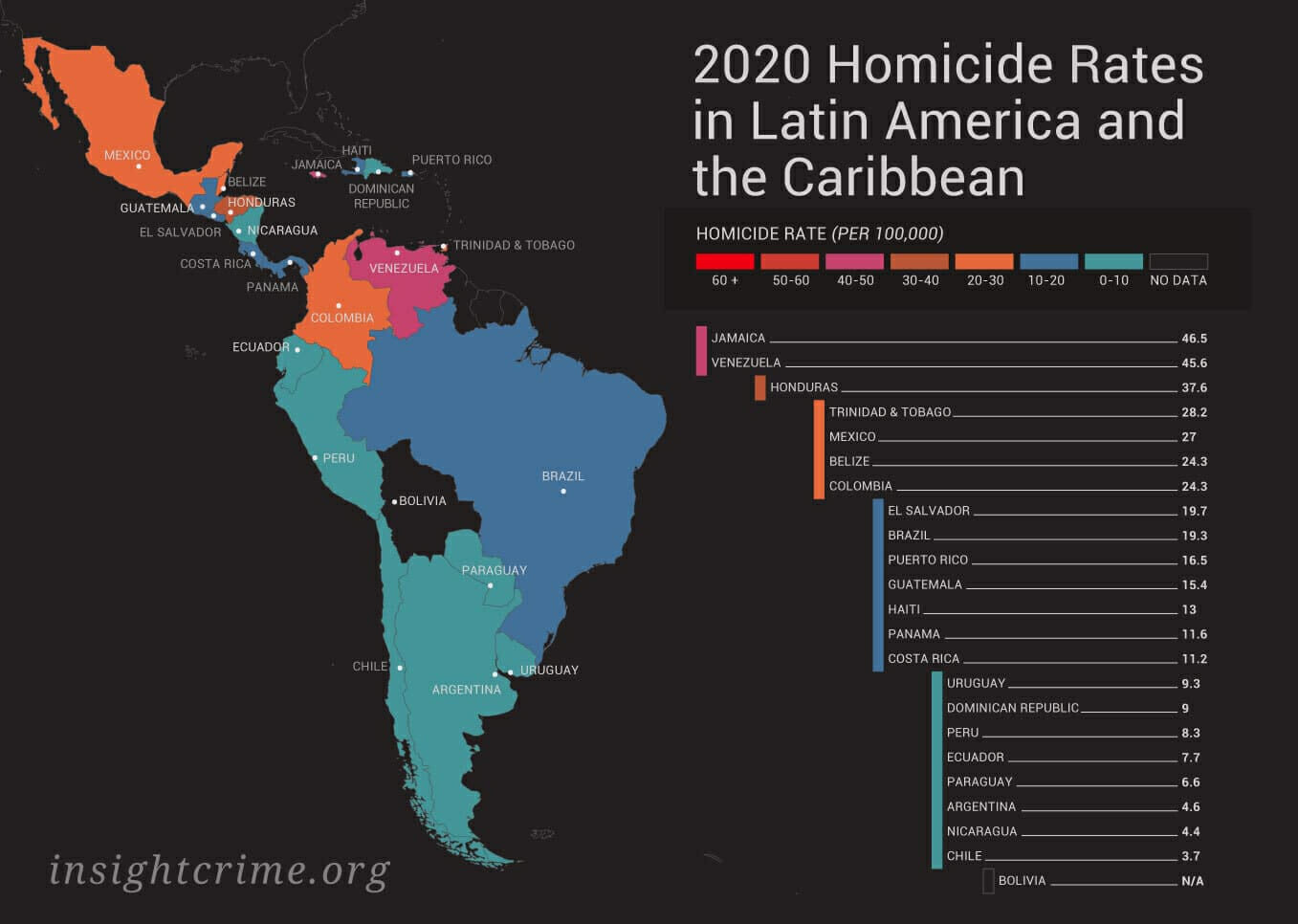
The Economics of Crime in the Caribbean
Caribbean states are renowned for their diversity. Their population size, their economic activities, their level of development, and their cultural heterogeneity. However, major commonalities exist across these countries, including porous borders and large maritime territories to patrol. These similarities and their geographical location give rise to crime and the drug trade, as the region lies in the middle of the supplier’s market to the south and the consumer’s demand to the north.
The extent of this criminality has been highlighted by Insight Crime’s 2020 Homicide Round-Up, where it was revealed that Jamaica now has the highest homicide rate throughout the Latin American and the Caribbean (LAC) region, peaking at 46.5 per 100,000 people. When compared with death rates across Western Europe, where homicides are below 1 per 100,000, this highlights the extent of the issue.
Other Caribbean states also top the list, with Trinidad and Tobago in 4th place with a homicide rate of 28.2 per 100,000 and Belize in 6th place reaching 24.3 per 100,000 people. Given the fact that the United Nations considers any homicide rate of 10 per 100,000 citizens or above to be an “epidemic,” this imposes a serious economic and social burden on countries in the region.
Given the bleak economic forecast for Caribbean countries in light of COVID-19, unemployment rates are likely to increase. This is a particular issue for the younger population, who had already experienced the highest levels of unemployment rates before the pandemic. As the largest number of arrests for criminal behaviour and homicides occur within the 18-30 age group, there is a clear indication that crime may increase, causing rising insecurity and increasing the economic costs of crime in the region.
The economic costs associated with crime
High rates of violent crime in the Caribbean pose a serious social and economic burden, directly affecting the region’s development rate. They also distort the allocation of both private and public resources which can have a significant impact on economic prospects, especially in the Caribbean, where several economies are stuck in a low-growth-high debt trap. It is estimated that crime-related costs in the region amount to 3.7 percent of GDP, which is comparable to the income share of the poorest 30 percent of the Caribbean population.

When compared to the LAC region, the Caribbean has the highest levels of crime-related expenditure by governments. Research suggests that the Caribbean spends more than 2 percent of GDP on public security (which includes spending on police, administration of justice, and prisons) which is around 0.5 percentage points of GDP higher than the LAC average. Traditionally, expenditure has been focused on law enforcement rather than other components of a potential solution, such as administration and justice. This has meant, that areas such as the court systems account for the smallest amount of spending in national budgets, even though research has shown that state investment in harsher penal laws and the nonstrategic expansion of police forces has had a limited impact on reducing violent crime.
Crime also affects a large portion of the private sector, through losses directly from crime and through spending to try and mitigate crime (for example, expenses related to private security). The amount that firms in the Caribbean spend on private security is higher than the international average, drawing money away from other activities that could potentially enhance productivity. Although nearly 70 percent of firms spend money on private security measures, this spending is not associated with a reduction in criminal activity. Some explanations for this include the idea that the majority of private security guards are poorly trained, in both conflict resolution and the safe handling of firearms, and are under paid making them increasingly susceptible to bribery and committing crimes themselves.
Aside from these costs, it has been suggested that high levels of crime and violence in the region create an economic multiplier effect, affecting inter-generational productivity. More specifically, crime and violence reduce an individual’s ability to participate in the labour market, decreasing their level of productivity on the job and their ability to have higher earnings. This will impact government revenue and policy decisions and will increase government spending. Alongside this, children witnessing or experiencing crime may have issues with school, resulting in lower educational attainment, in effect, repeating the cycle.
The high costs of crime suggest that reducing crime in the Caribbean would result in significant economic gains. Laura Jaitman has shown that GDP growth for the region would have been 1.14 percent higher annually if homicide rates had been reduced to global averages. These growth gains suggest that an accelerated effort to reduce crime should be put in place, more pressingly so in the aftermath of the pandemic which has seen the evolution of different areas of criminal activity which could potentially increase the economic costs of organised crime.

Evolving areas of crime and their implications for economic costs
COVID-19 has changed routine activities, causing a paradigm shift in the Caribbean region which has enabled criminal opportunism to take place. Cybercrime is a perfect example of this, with an increasing number of criminals launching cyberattacks on financial infrastructure and other electronic data platforms. Because available data on this topic is scarce for the region, this implies that researchers may not have incorporated these potential costs into their estimates, suggesting that the costs of crime are likely higher than projections suggest, highlighting the pressing need for increased government policies and monitoring in this area.
Ponzi and pyramid schemes have also proliferated across Caribbean countries during the pandemic, as financial fraud has become a low priority for governments that are scrambling to reduce COVID-19 cases. Estimates suggest that these schemes have already cost would-be investors hundreds of millions of dollars in Antigua and Barbuda, Barbados, Guyana, Jamaica, and Trinidad and Tobago. This emphasizes the need for both financial regulators and law enforcement authorities to identify and stop schemes in order to protect investors’ interests.
Previous disasters, such as tropical storms in the Caribbean, have demonstrated the ability of criminals, who are organized, to commit fraud and misappropriate public funds. As flows of money continue to enter the region in order to tackle the aftermath of the pandemic, through, for example, aid destined for distressed companies or protection for the most vulnerable populations, opportunities for the appropriation of public funds by organised criminal groups will rise. This could cause increasing economic costs for governments as not only do they lose these funds to criminal groups, but they will need to replace them as the economic stimulus may be too small to produce a significant effect, leaving businesses and workers in vulnerable economic positions.
The way forward
Although we have seen that there are significant economic costs due to organised crime in the Caribbean, COVID-19 has slowed and constrained a certain amount of criminal activity, especially in the areas of drug trafficking and illicit firearms. Nonetheless, the disruption that the pandemic has caused has been exploited by criminals, suggesting that they have in fact just found new ways of working that could be just as economically detrimental. These newfound ways of operating have allowed for economic resources to be diverted, reducing the ability for governments to effectively use their funds and address the needs of those most affected by the pandemic.
Whilst Caribbean governments’ focus should be on trying to mitigate the direct impacts of the pandemic, it will be crucial that they continue to be informed and aware of evolving criminal activities, allowing them to prepare and implement plans to help reduce crime in the region. A key aspect of this is addressing both disinformation online and tackling cybercrime, helping to protect the welfare and economic wellbeing of citizens. Analysing the trade-off between substantial and swift liquidity injections and a higher risk of misuse of public funds will also be crucial and implementing safeguarding measures will help to address this. Finally, focusing on marginalised communities, especially youth populations in the region, will be essential in order not to further exacerbate current crime rates. These actions will require both financial and political support in the face of restricted budgets and ensuring that interventions are both targeted and evidence-based will be crucial in order for these budgets to be used to their full potential.
The views expressed in this article are those of the author alone and do not necessarily reflect those of any institutions with which the author is associated.

